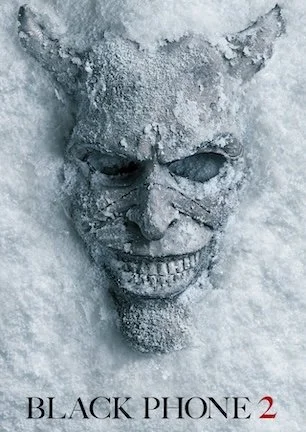Studio: Dark Sky Films
Director: Bradford Baruh
Writer: Irving Walker, Bradford Baruh
Producer: Andy Meyers, Bradford Baruh
Stars: Brea Grant, AJ Bowen, Sophie Dalah, Elise Luthman, Joshua Hoffman, Daniel Roebuck, Joy Osmanski, Kay D’Arcy, Sky Soleil, Alexander Ward, Barbara Crampton
Review Score:
Summary:
A spiritualistic healing retreat in snowy woods turns deadly when a family of five encounters a mysterious woman.
Review:
Early words out of Fantastic Fest 2017 weren’t terribly kind to “Applecart.” Some saw intentional humor in the movie’s bizarre newsmagazine narrative while applauding genre icon Barbara Crampton’s against-type turn as a vampy villain. Many published critics and average attendees were content to call the film a hot mess made messier by its ill-fitting dual storylines.
Taking the unfavorable reviews to heart, the filmmakers went back to the edit bay to re-cut “Applecart” for its second screening at Cinepocalypse two months later. Three months after that, “Applecart” was washing off some of its stigmatic stink by going under the new title “Dead Night” while shopping for distribution at the European Film Market.
I didn’t see “Dead Night” under its “Applecart” incarnation, although I kind of wish I had. Mostly because “Dead Night” is so incomprehensibly conceived, I’m morbidly curious how much worse “Applecart” possibly could have been. No amount of retooling can salvage a watchable film out of scrap when the core story and available footage are this fundamentally flawed.
As near as I can gather, changes made since the movie’s premiere appear largely related to excising several clips from the “true crime” TV show from the future that alternates with the plotline occurring in the present. Two other reviews reference jailhouse interviews with Brea Grant’s character that don’t appear in the home video version at any rate.
Now is as good of a time as any to mention that whatever director Bradford Baruh intended to accomplish with these newsmagazine non-sequiturs, it didn’t work. Some speculate that the nonsensical nature of the segments, highlighted by Daniel Roebuck overplaying the host almost as hammily as Bill Hader did his Keith Morrison impression on SNL, means to satirically skewer consumption of docutainment television. Others contend that the divergent viewpoints regarding events in the film shine a light on how popular perception can actually be the misinformed perspective.
I say, “pfft.” With unclear tone violently wobbling to and fro like Andy Capp on a bender, playing these predictive clips in parallel undermines suspense by showing us the entire road before the engine even turns over. “Dead Night” becomes a prime example of why it rarely works in a mystery’s best interests to show/tell us the ending ahead of time, taking tension out of upcoming scenes in the process.
I can’t offer a concise plot summary because frankly, I’m not certain what “Dead Night’s” story is. The setup, on the other hand, involves Casey Pollack, whom we are told will go on to become a murderer known as “Axe Mom,” taking her ill husband James to a remote cabin built on land thought to have spiritual healing properties. With them are teen son Jason, teen daughter Jessica, and Jessica’s friend Becky.
We’re introduced to the facts above through some painfully obvious expository dialogue. Casey tells Jason, “stop trying to impress your sister’s friend!” James says, “your mom didn’t tell you the cabin’s built on a pile of magic rocks? … Your mom’s trying to cure me.” You know, the way people naturally talk by referring to everyone using names and relationships as well as explaining motivations behind every action.
Once at the cabin, the girls sneak a cigarette while discussing inconsequential family problems, Jason has difficulty downloading porn to remind us that cellphone connectivity is spotty, and everyone generally wastes time until mystery woman Leslie Bison shows up on the scene. Leslie, a candidate for Oregon governor of all things, connects to some creepy people wearing tattered robes in the woods who assemble around a spiral rock that grows pulsing pink pods. If that prior sentence inspires a “wait, what?” reaction, get used to it. “Dead Night” interjects many more head-scratchers before its scatterbrained script finally comes to its confusing close.
Every odd directorial choice triggers a question regarding details. Why does text specify the month, day, and year for the first two scenes when a simple “54 Years Later” would suffice? What value is there in having Leslie’s crony pull down trees offscreen so a random ranger can find the blockade, even though police have no problem driving past it just a few minutes later? Who still finds it stylish to score a murder montage to an operatic aria, as if Hannibal Lecter clones didn’t kill that conceit countless years ago?
Credits listing characters not seen in the film to my recollection, including Jenni Whitmore, Karl Durant, Amanda Tate, and Manny and Kate Rothwell, suggest the slim 75-minute duration might relate to even more cut content. I can’t imagine the fiction being any easier to follow if such scenes were included however. As said before, if this is what “Dead Night” looks like, imagine the shambles “Applecart” must have been in.
On a technical level, “Dead Night” actually looks pretty good. Packed with gloriously gruesome practical effects that easily would have earned a Fangoria cover in 1991, gorehounds at least get some satisfaction from the film’s spectacularly cinematic carnage.
But when a film features “Phantasm” (review here) architect Don Coscarelli as executive producer, “Insidious” and “The Conjuring” (review here) composer Joseph Bishara on music, and familiar L.A. horror faces Brea Grant, AJ Bowen, and Chase Williamson in its cast, horror fans are right to expect something more than what “Dead Night” disappointingly delivers. At the very least, they should expect a movie that makes some semblance of sense, which “Dead Night” definitely does not.
NOTE: There is a post-credits scene.
Review Score: 40






Compelling performances keep “Hallow Road” swimming as strongly as possible against the strong current of a drowsy pace.